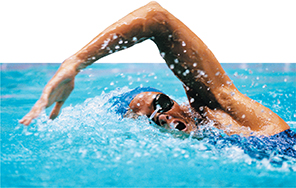Newton's Third Law
A force cannot exist alone. Forces always exist in pairs.  According to Newton's third law of motion, whenever one object exerts a force on a second object, the second object exerts an equal and opposite force on the first object. These two forces are called action and reaction forces.
According to Newton's third law of motion, whenever one object exerts a force on a second object, the second object exerts an equal and opposite force on the first object. These two forces are called action and reaction forces.
Action and Reaction Forces
The force your bumper car exerts on the other car is the action force. The force the other car exerts on your car is the reaction force. These two forces are equal in size and opposite in direction.
Pressing your hand against a wall also produces a pair of forces. As you press against the wall, your hand exerts a force on the wall. This is the action force. The wall exerts an equal and opposite force against your hand. This is the reaction force.
A similar situation occurs when you use a hammer to drive a nail into a piece of wood. When the hammer strikes the nail, it applies a force to the nail. This action force drives the nail into the piece of wood. Is there a reaction force? According to Newton's third law there must be an equal and opposite reaction force. The nail supplies the reaction force by exerting an equal and opposite force on the hammer. It is this reaction force that brings the motion of the hammer to a stop.
Action-Reaction Forces and Motion
Can you determine the action and reaction forces occurring in Figure 16? The swimmer uses her arms to push against the water and create an action force. The action force causes the water to move in the direction of the action force. However, the water also exerts its equal and opposite reaction force on the swimmer. The reaction force acts on the swimmer and pushes her forward through the water.
Unlike the swimmer in Figure 16, not all action and reaction forces produce motion. Pushing against the wall with your hand is an example of an action-reaction force pair that does not result in motion.
Action-Reaction Forces Do Not Cancel
You may be wondering why the action and reaction forces acting on the swimmer in Figure 16 do not cancel each other and produce a net force of zero. The reason is that the action and reaction forces do not act on the same object. The action force acts on the water, and the reaction force acts on the swimmer. Only when equal and opposite forces act on the same object do they result in a net force of zero.

Figure 16 Action-reaction forces propel the swimmer through the water. The swimmer pushes against the water, and the water pushes the swimmer ahead.
Comparing and Contrasting Describe the magnitude and direction of the action and reaction forces acting on the swimmer.






